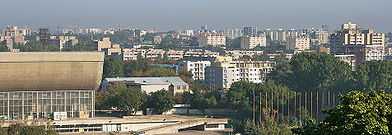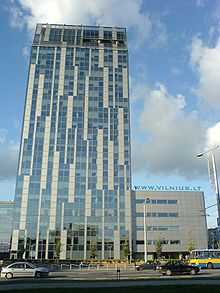Vilnius city municipality
| Vilnius City Municipality Vilniaus miesto savivaldybė | ||
|---|---|---|
| Municipality | ||
| ||
 | ||
| Country |
| |
| Ethnographic region | Dzūkija | |
| County | Vilnius County | |
| Capital | Vilnius | |
| Elderships | 21 | |
| Government | ||
| • Mayor | Artūras Zuokas (2011-) | |
| • Council size | 51 members | |
| Area | ||
| • Total | 400.6 km2 (154.7 sq mi) | |
| Area rank | 51st | |
| Population (2001 census) | ||
| • Total | 554,300 | |
| • Rank | 1st | |
| • Density | 1,400/km2 (3,600/sq mi) | |
| • Density rank | 7th | |
| Time zone | EET (UTC+2) | |
| • Summer (DST) | EEST (UTC+3) | |
| Telephone code | 5 | |
| Major settlements | ||
| Website | www.vilnius.lt | |
The Vilnius City Municipality (Lithuanian: Vilniaus miesto savivaldybė), is one of 60 municipalities in Lithuania. It is in the southeastern part of country, in Vilnius County and consists of the city of Vilnius, the town of Grigiškės and some rural areas.
History
This is the history of the municipality. For the history of Vilnius city itself, please see History of Vilnius.
During the Soviet era, Vilnius was given the unique status of a city, that was not controlled by local governments, but was responsible directly to the central government of the Lithuanian SSR. Officially, it remained a part of the Vilnius district.
After independence the system of districts and republican administered cities was reorganized into that of municipalities. Therefore the territory that formerly included Vilnius, became the Vilnius city municipality, while the remaining areas of Vilnius district became Vilnius District Municipality. Although whole area is considered Vilnius, it has some areas that are actually suburbs, separated from the city by forests and such.
Under the municipality reform of 2000, the town of Grigiškės was separated from the Trakai District Municipality, and made part of the Vilnius city municipality. It became an elderate (a unique Lithuanian designation) of this municipality. However, Grigiškės is not considered part of Vilnius, only of the municipality. That is because joining it with Vilnius, would require renaming many streets in both cities, and it would be too costly at this time.
The government of Vilnius City Municipality also would like that the town of Lentvaris, currently part of Trakai District Municipality, would be attached to the Vilnius City Municipality (which is allegedly supported by people of Lentvaris, according to surveys done by Vilnius City Municipality). This is opposed by the government of Trakai District Municipality.
Geography

The population density of the municipality is almost 1,400 people per square kilometer. In spite of this, however, almost a half of it is covered by woods and greenery. Parks separate the different districts and forests separate Vilnius from its suburbs. There are recreational places such as lakes in the municipality (water makes up almost 3% of the area). Outside of the Vilnius city limits it is also possible to swim in the Neris River. Forests are also prevalent in the northern part of the municipality.
The Vilnius District Municipality surrounds Vilnius city municipality from the north, east and south, while in the west Vilnius City Municipality borders Trakai District Municipality.
Demographics
The Vilnius city municipality is the most populous municipality in Lithuania and is one of the most diverse municipalities, with Lithuanians making 62% (census, 2011) of the population. The minority communities are Poles, Russians, Belarusians, Ukrainians, Jews, Tatars, Gypsies, Karaites and others; most of them have resided there for centuries. There are many Lithuanian, Polish and Russian schools, as well as some other minority schools. There are also various religious communities in the municipality (also many atheists, as in other urban municipalities), including various Christian denominations, the largest number of Jews of any Lithuanian municipality, relatively large number of Muslims, also some Karaites (who have a temple in the city). In addition to traditional religions, there are many new ones practiced. Such diversity comes from the turbulent history of the region. The percentage of Poles is largest in the suburbs of Vilnius, such as Naujoji Vilnia, most Russians live in Vilnius itself.
Urbanization:
- Urban - 553,735 (99.97%)
- Rural - 169 (0.03%)

Sexual makeup:
- Men - 252,464 (45.58%)
- Women - 301,440 (54.42%)
Religious makeup:
- Roman Catholics - 366,052 (72.32%)
- Atheists - 71,463 (14.12%)
- Eastern Orthodox - 54,530 (10.77%)
- Old Believers - 6,507 (1.29%)
- Others less than 0.5% each
Ethnic makeup:
- Lithuanians - 318,510 (59.16%)
- Poles - 104,446 (19.40%)
- Russians - 77,698 (14.43%)
- Belarusians - 22,555 (4.19%)
- Ukrainians - 7,159 (1.33%)
- Jews - 2,785 (0.52%)
- Others less than 0.5% each
Politics

As the municipality is the most populous, and as it includes the capital city of Lithuania, it is very important. It has the largest city council. Since April, 2011 the mayor of Vilnius is Artūras Zuokas.
Some of the actions of the municipality government were pioneering the ideas in Lithuania or even the world. The innovative actions were such as letting people always see the mayor's office online over a webcam, giving people free bikes to ride with and otherwise promoting bike travel (which was not popular before), banning of any public alcohol consumption (previously not done in Lithuania), installing TV sets in public transportation, allowing tall skyscrapers near city centre (previously undone in Lithuania) and others. As mayor Artūras Zuokas said, it is a problem of Lithuania and other Eastern European societies that one has to prove that the idea has been done in different western European or American cities before anyone takes you seriously that it would work in Lithuania; he thinks that instead Lithuanians should not be afraid to be the first in the world to do various things and let others to follow.
Goals
Declared political goals of Vilnius city municipality are quite ambitious; they include trying to make the city a major commercial hub in the region which includes Lithuania, Latvia, Belarus and Poland (as Vilnius is a center of an area inhabited by tens of millions of people, and cities of Kaunas, Riga, and Minsk are not far away.

The new city center of Vilnius, a commercial and residential modern district, is being established in formerly empty areas, or areas currently occupied by outdated and obsolete sports facilities and wooden buildings, on the right bank of river Neris. To further establish the stance of the area as the center, the municipality itself moved to a newly built high-rise building there. The former Municipality Palace in the Gediminas Avenue was sold and now there is a shopping centre. Although one of reasons for the new center of Vilnius is that it would move away traffic from the old town, the project is still regarded by some as controversial, due to skyscrapers being visible from the old town and supposedly destroying the medieval atmosphere there, skyscrapers being more impressive visually than the traditional symbols of Vilnius such as the Castle of Gediminas and the new districts destroying the wooden architecture of Šnipiškės district, a rare case of XIX age former suburb of Vilnius still remaining as it was unchanged. The municipality government however discounts such arguments as being old-fashioned and states that the municipality must move forward together with time.[citation needed]
Inside Lithuania, the dvimiestis (literally "twocity") idea is a common work between Vilnius city municipality and Kaunas city municipality (second most populous municipality of Lithuania (includes Kaunas city), which is about 100 km from Vilnius city municipality). It includes cooperation such as planning a single major airport between municipalities; also plans are for a fast train which would connect them in half an hour so it would make it viable to live in one municipality and work in another (currently it takes 1 hour and 5 minutes to go Vilnius–Kaunas by express train and 1 hour and 40 minutes to go by express bus). Overall both municipalities would then have almost a million people and this would make it easier to advertise it as a common market to possible investors. Currently in major exhibitions and tourist booklets both municipalities already advertise together.
Another idea is that of expansion of the municipality by including the town of Lentvaris into it which is currently part of Trakai district municipality. Allegedly, that is supported by people of Lentvaris, according to surveys organised by Vilnius city municipality, mostly because utilities (such as water) are cheaper in Vilnius city municipality as it is highly urban.[citation needed] Trakai District Municipality, which already had Elektrėnai Municipality seceded from it in 2000 and Grigiškės attached to Vilnius City Municipality previously, disagrees with possible secession of Lentvaris, claiming that then the municipality would remain primarily rural and costs for utilities would get even larger for those who would remain. Also, some opponents of the idea claim that Vilnius City Municipality needs Lentvaris only as a cheap ground to plan industry in, as Vilnius City Municipality itself is highly urban and large parts of remaining areas are protected as regional parks.[citation needed]
Council
Vilnius City Municipality council is the governing body of the Vilnius city municipality. It is responsible for municipality laws. The council is the member of the Association of Local Authorities in Lithuania. Vilnius City Municipality council overall has 51 seats. Last elections were held in February 2011, terms are 4 years. The results are here:
- Arturas Zuokas and Vilnius Coalition - 12
- The coalition of the Electoral Action of Poles in Lithuania and Lithuanian Russian Union - 11
- Homeland Union – Lithuanian Christian Democrats - 10
- Labour Party - 8
- Social Democratic Party of Lithuania - 5
- Order and Justice - 5
Mayors
- 1990 – Arūnas Grumadas (the president of council)
- 1993 – Valentinas Šapalas (the president of council)
- 1995 – Alis Vidūnas
- 1997 – Rolandas Paksas
- 1999 – Juozas Imbrasas
- 2000 – Rolandas Paksas
- 2001 – Artūras Zuokas
- 2003 – Gediminas Paviržis
- 2003 – Artūras Zuokas
- 2007 – Juozas Imbrasas
- 2009 – Vilius Navickas
- 2010 – Raimundas Alekna
- 2011 - Artūras Zuokas
Economics
The municipality thrives economically, unemployment is among the lowest and average wage is among the highest in Lithuania. Economic policies however criticised by some people because such things as green areas and old buildings are being sacrificed for skyscrapers and other commercial objects. The government of municipality however envisions Vilnius as a modern European city and during past few years it rapidly changed. Other parts of the municipality are developing too. Due to good economic policies, municipality is attractive to investors; it already houses tallest skyscraper Europa Tower, largest shopping center Akropolis in the Baltic States and other such objects.
Transport
Municipality has largest international airport in Lithuania (Vilnius International Airport), is connected by major roads and railways. There are plans to build a Light rail system in the municipality to promote public transport. Currently public transport consists of buses and trolleybusses, as well shared taxis and taxis.
Elderates

- Verkiai
- Antakalnis
- Pašilaičiai
- Fabijoniškės
- Pilaitė
- Justiniškės
- Viršuliškės
- Šeškinė
- Šnipiškės
- Žirmūnai
- Karoliniškės
- Žvėrynas
- Grigiškės
- Lazdynai
- Vilkpėdė
- Naujamiestis
- Senamiestis (Old Town)
- Naujoji Vilnia
- Paneriai
- Naujininkai
- Rasos
Culture
Cultural life is very active in the municipality. There are several theaters (some of which are world famous and takes part in various international festivals), cinemas, art galleries and other cultural institutions.
External links
- {en;9;0} Vilnius Municipality Website - Interactive map of Vilnius' neighbourhoods.
| ||||||||||||||||
| |||||||||||
Coordinates: 54°41′N 25°17′E / 54.683°N 25.283°E

